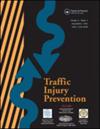Speed-securing measures on rural roads in Sweden: An observational study
IF 1.6
3区 工程技术
Q3 PUBLIC, ENVIRONMENTAL & OCCUPATIONAL HEALTH
引用次数: 0
Abstract
Objective
Speed-securing measures are intended to, as the name suggests, to secure that the speeds of road users do not exceed the safe speed for a given type of environment. The purpose of this study was to make an evaluation of existing speed-securing measures on rural roads in Sweden to see how well they manage to limit the speed.
Methods and data
A total of 34 unique locations have been filmed with drones with varying speed limits between 40 and 70 km/h. The analysis focused on the radius of both the individual vehicle trajectories and the radius of the roads themselves and how they relate to the speed choice of the drivers (including the 85th percentile speed).
Results
The result shows a moderate correlation between both types of radii and the speed choice of the drivers. In addition, the result also shows only a weak correlation between the driven radius and the radius of the roads themselves. Finally, the result also shows that only 17 locations manage to keep the 85th percentile speeds under the speed limit.
Conclusion
Overall, the study suggests that the radius of the infrastructure is an important factor to lower the speed but the lack of a clear relationship between the driven radius and the radius of the road shows that more research is needed to properly understand why some locations work better than others.
瑞典农村道路上的车速安全措施:观察研究。
目标:顾名思义,限速措施旨在确保道路使用者的车速不超过特定环境下的安全车速。本研究的目的是对瑞典乡村道路上现有的车速安全措施进行评估,以了解这些措施在限制车速方面的效果:方法和数据:使用无人机拍摄了 34 个不同地点,限速范围在 40 至 70 公里/小时之间。分析的重点是单个车辆轨迹的半径和道路本身的半径,以及它们与驾驶员的速度选择(包括第 85 百分位速度)之间的关系:结果表明,这两种半径与驾驶员的速度选择之间存在一定的相关性。此外,结果还显示,驾驶半径与道路本身的半径之间只有微弱的相关性。最后,结果还显示,只有 17 个地点能够将第 85 百分位数车速控制在限速以内:总之,研究表明,基础设施的半径是降低车速的一个重要因素,但行驶半径与道路半径之间缺乏明确的关系,这表明需要进行更多的研究,以正确理解为什么有些地点比其他地点更有效。
本文章由计算机程序翻译,如有差异,请以英文原文为准。
求助全文
约1分钟内获得全文
求助全文
来源期刊

Traffic Injury Prevention
PUBLIC, ENVIRONMENTAL & OCCUPATIONAL HEALTH-
CiteScore
3.60
自引率
10.00%
发文量
137
审稿时长
3 months
期刊介绍:
The purpose of Traffic Injury Prevention is to bridge the disciplines of medicine, engineering, public health and traffic safety in order to foster the science of traffic injury prevention. The archival journal focuses on research, interventions and evaluations within the areas of traffic safety, crash causation, injury prevention and treatment.
General topics within the journal''s scope are driver behavior, road infrastructure, emerging crash avoidance technologies, crash and injury epidemiology, alcohol and drugs, impact injury biomechanics, vehicle crashworthiness, occupant restraints, pedestrian safety, evaluation of interventions, economic consequences and emergency and clinical care with specific application to traffic injury prevention. The journal includes full length papers, review articles, case studies, brief technical notes and commentaries.
 求助内容:
求助内容: 应助结果提醒方式:
应助结果提醒方式:


